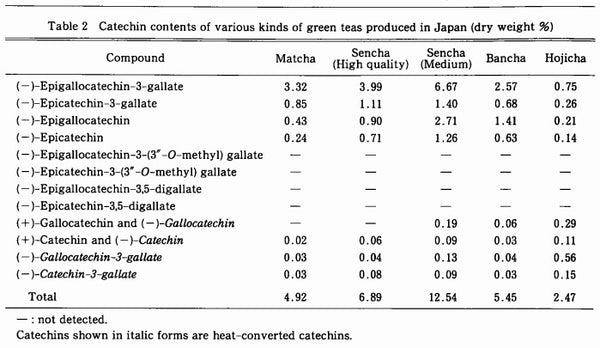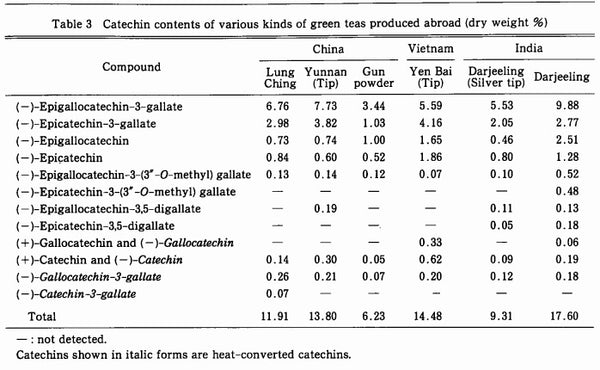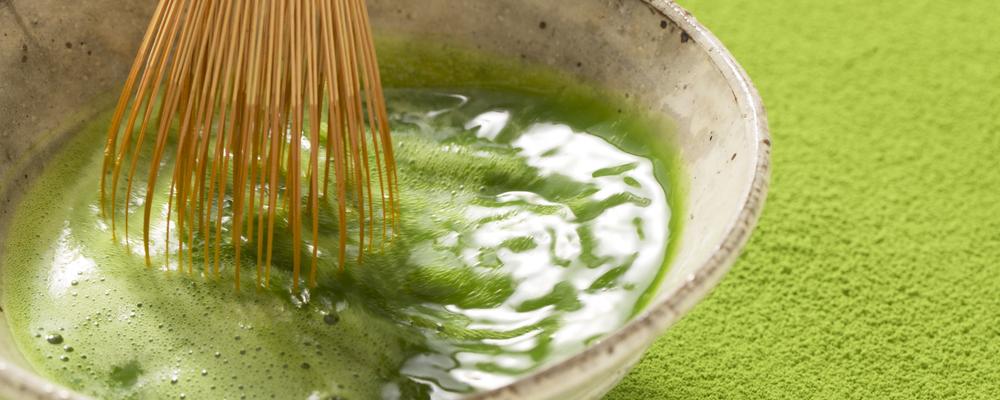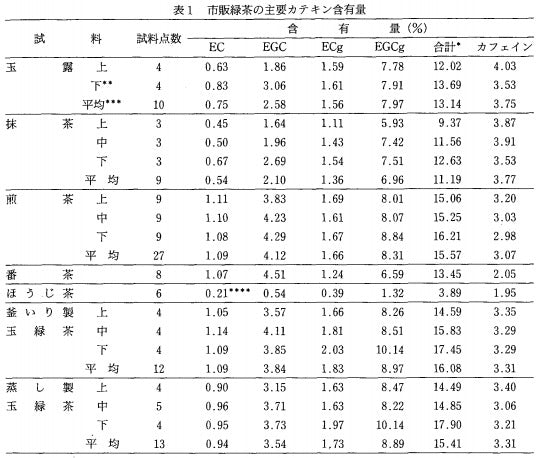The myth of matcha
There are many companies misquoting a certain study examining the levels of EGCG (a specific type of catechin, itself a kind of antioxidant). These companies say that matcha has 137x the level of antioxidants as green tea.
Blog posts at Green Tea Guide and Matcha Mind Tea pointed out specifically where this figure was coming from, a study at the University of Colorado.
That study, like so many others, needs to be examined more carefully (and read if possible of course). But even by looking at the abstract (below) you can see how marketers have taken the "137" figure out of context (highlights are mine.):
Catechins in green tea are known to have many beneficial health properties. Recently, it has been suggested that matcha has greater potential health benefits than other green teas. Matcha is a special powdered green tea used in the Japanese tea ceremony. However, there has been no investigation to quantitate the catechin intake from matcha compared to common green teas. We have developed a rapid method of analysis of five catechins and caffeine in matcha using micellar electrokinetic chromatography. Results are presented for water and methanol extractions of matcha compared with water extraction of a popular green tea. Using a mg catechin/g of dry leaf comparison, results indicate that the concentration of epigallocatechin gallate (EGCG) available from drinking matcha is 137 times greater than the amount of EGCG available from China Green Tips green tea, and at least three times higher than the largest literature value for other green teas.
China Green Tips is, of course, a specific tea product from Starbucks, not green tea in general. Both Green Tea Guide and Matcha Mind Tea point out that 137x the level of average green tea would be dangerous.
What about powdered green tea?
What is common in Japan for those seeking to increase their dietary intake of catechin through green tea is drinking powdered green tea. In fact, on average, nearly all green teas (roasted hojicha is the exception) has more catechin than matcha if consumed in powdered form.
The analysis from the study, "HPLC Analysis of Catechins in Various Kinds of Green Teas Produced in Japan and Abroad," shows levels of catechins as a percentage of dry weight:


Saijo, Ryoyasu*, and Yoshiyuki Takeda**. "HPLC Analysis of Catechins in Various Kinds of Green Teas Produced in Japan and Abroad," Nippon Shokuhin Kagaku Kogaku Kaishi Vol. 46, No. 3. 138-47 (1999).
* Faculty of Education , Kagawa University, Saiwaicho 1-1, Takamatsu-shi Kagawa 760-8522
** Department of Tea Cultivation (Makurazaki) , NIVOT, Beppu 14041, Makurazaki-shi Kagoshima 898-0032
Interestingly, another study, "Contents of Individual Tea Catechins and Caffeine in Japanese Green Tea", shows very different percentage levels, though this study examines many more samples of green teas from Japan (85 samples total of various types of teas). Here again, though, matcha has less than other green teas except hojicha.
From top to bottom: Gyokuro high quality, gyokuro low quality, gyokuro average; Matcha high quality, matcha medium quality, matcha low quality, matcha average; Sencha high quality, sencha medium quality, sencha low quality, sencha average; bancha, hojicha, pan-fired tamaryokucha high, medium, low, average; steamed tamaryokucha high, medium, low, average.
First column of numbers lists the number of samples. Second-to-last lists the total catechins, the final column lists caffeine.
Goto, Testuhisa, Hitoshi Nagashima, Yuko Yoshida, and Masaaki Kiso. "Contents of Individual Tea Catechins and Caffeine in Japanese Green Tea," Chagyo Kenkyu Hokoku (Tea Research Journal) Vol. 1996 (1996) No. 83. 21-28.
Testuhisa Goto and Hitoshi Nagashima are from the National Food Research Institute. Yuko Yoshida and Masaaki Kiso are from the Tokyo Metropolitan Agricultural Experiment Station.
Finding a balance between health and flavor
The main thing to remember is that catechin is bitter tasting. The more bitter your tea is, the higher the amount of catechin. If you are sticking to tea leaves, then you'll find tea steeped in water above 80C/176F degree to be more bitter than the same tea leaf steeped below this level (try this with a shaded gyokuro or kabusecha!). 80C is the threshold where most of the catechin is extracted.
For powdered teas, some tea are quite good at limiting the bitterness despite consuming the entire leaf. Like matcha, because you would be consuming the entire leaf, you'll be able to get the highest amount of antioxidants into your body.
Image credit: kazoka / Shutterstock




6 comments
The methanol extraction of the powder vs the water extraction of the green tea may not be as bad a comparison as you would first think.
The water extraction of the green tea is what the person actually consumes, so it is easy to then prepare this sample for the chromatography and assess what is present.
The matcha powder is fully consumed, so it needs to be understood what is present in the powder. To see what is present, the powder needs to be prepared in such a way that the chromatography method can detect what compounds are present. This usually takes form in a methanol extraction.
The methods and comparison are fine, the only caveat that should be included is that while there may be 137x the compounds present in match vs green tea, there is the very real possibility (and high probability) that the body would not be able to extract that full amount.
Hi Marc, First of all, you do need to be careful about generalizing. Ichibancha or first flush and nibancha or second flush, refers only to the specific flush, and says nothing about cultivation or production. Given the exact same amount of exposure to sunlight and the same tea field, I would say that first flush leaves have more of all components. If you shade the leaves, there will be less exposure to sunlight so more theanine and less catechin. Most farmers allow their second flush to grow longer (resulting in more sunlight exposure) to get a larger crop yield, so the tendency is for more catechin. But I would say the second flush also has less caffeine.
Hi Ian,
Is it accurate that Shincha/Ichibancha sencha has less caffeine, less catechins but higher amino acids (I assume that by higher amino acids, people refer mainly to L-theanine ) than Nibancha harvested sencha ?
My understanding is that catechins are actually produced from L-theanine with the help of direct/full sun exposure. Since Shincha/ichibancha means spring harvest, such leaves have seen little sun exposure, so I’d expect the claim of higher L-theanine and lower amount of catechins to be accurate. However, I’m not so sure about lower amount of caffeine. The reason I say that, is because gyokuro which generally has higher amounts of L-theanine than sencha, also has higher amounts of caffeine than sencha.
As far as I know the effects of green tea relies on the ratio of three main components : theanine, catechins and caffeine.
I’m looking to find the general ratios of the above in both ichibancha and nibancha. Off the top of my head, as far as Nibancha, I’d assume lower amounts of L-theanine, higher amounts of catechins and lower amounts of caffeine.
Am I mistaken ?
Many thanks
Hi Marc, I am not a food scientist, so I am speaking only with knowledge as someone who has read a lot about this in Japanese. “Sencha Nagashima” is almost certainly a product name, not a type of sencha, so I am going assume that the “high fired” term you use is 火入れ in Japanese, hi-ire, what we call “green roasting” here on Yunomi, and a process where you heat sencha in a roaster on low heat for a short time so as not dry it out more without actually roasting it. This has the effect of reducing moisture from unrefined tea leaves (aracha) at 5% to 1-2%, imparting a sweet toastiness without removing too much of the vegetal flavor, and allows for storage of 6-18 months much less decline in quality.
I do know that roasting the leaf to the point of hojicha reduces the amount of caffeine and reduces the catechin in the leaf. How much green roasting reduces this is something I do not know though.You can see the general difference between sencha and hojicha here: https://yunomi.life/blogs/japanese-tea-guide/japanese-tea-nutrition-chart
I’ll take a look to see if any Japanese research has been done on this hi-ire process.
This question is about Japanese sencha :
Mood wise I benefit from most first-flush sencha, but one ; sencha Nagashima which is a high-fired tea. I suspect this lack of effect has to do with it being high-fired. I’ve seen an HPLC analysis of that tea and it’s been found to have a high amount of polyphenols – though this is a bit vague as there are many types of polyphenols present in sencha.
Do you think the high-firing process causes polymerization ? This might explain why it’s been found to have a high amounts of polyphenols and why I don’t get the mood benefit from this one tea.
This question is about Japanese sencha.
I’ve been drinking sencha for 9 years now. I drink sencha for the overall experience and the effect it has on my mood and overall health. Most sencha improve my mood.
One type of sencha however, doesn’t produce that effect – it is high-fired sencha (i.e. Sencha Nagashima). I’m wondering why that is ? I’ve seen an HPLC analysis of that tea and it has a high amount of polyphenols – though, that is somewhat vague, as there are many types of polyphenols in sencha.
I’m pretty sure it has to do with it being high-fired where other sencha teas I drink aren’t.
Could the high-fired process cause polymerization ? That might explain why it has a high amount of polyphenols and why I don’t benefit from that tea.
Thank you